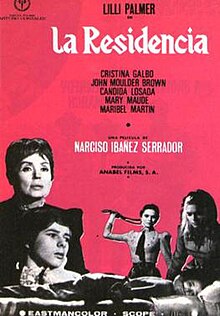La residencia
| The House That Screamed | |
|---|---|

Spanish film poster
|
|
| Directed by | Narciso Ibáñez Serrador |
| Produced by |
Arturo González Jose M. Maldonado |
| Written by | Narciso Ibáñez Serrador Story: Juan Tébar |
| Starring |
Lilli Palmer Cristina Galbó John Moulder-Brown Mary Maude |
| Music by | Waldo de los Ríos |
| Cinematography | Manuel Berenguer Godofredo Pacheco |
| Edited by | Mercedes Alonso Reginald Mills |
|
Release date
|
|
|
Running time
|
99 minutes |
| Country | Spain |
| Language | English |
| Box office | ESP 104,871,715 (Spain) |
The House That Screamed (Spanish: La residencia) is a 1969 Spanish horror film directed by Narciso Ibáñez Serrador. The film stars Lilli Palmer as Señora Fourneau the headmistress of a nineteenth-century French boarding school for girls where the students begin to disappear under unusual circumstances. The film was also released under the title The Boarding School.
In a 19th-century French boarding school for troubled girls, Headmistress Señora Fourneau (Lilli Palmer) forbids her teenage son Luis (John Moulder-Brown) near any of the girls, finding none of them good enough for him. A series of murders begin taking place after the latest arrival of a new student, Teresa (Cristina Galbó), and Fourneau's assistant Irene (Mary Maude). Fourneau investigates these deaths, eventually leading her to the attic where she finds that Luis' frustrated desires have forced psychotic urges to the surface, compelling him to stalk the hapless girls to acquire body parts in order to create his own "ideal woman". Luis then locks up his mother with his new creation so that his mother can get acquainted with her future "daughter-in-law".
La residencia was director Narciso Ibáñez Serrador's first horror film. The screenplay is based on a story by Juan Tébar. Serrador wrote the screenplay under the name "Luis Peñafiel."
The film was created as a commercial film with the express purpose of breaking into the international market. The film was shot in English, making it the first Spanish film shot in this language.
Director Narciso Ibáñez Serrador did not appreciate how the film had been promoted, stating that it was "terribly promoted, promoted with clichés". The film was released by American International Pictures in the United States and did not do well with contemporary American audiences.
The film was released in Spain to very mixed reviews. Antonio Pelayo of Cinestudio wrote a review questioning the budget of the film, stating that other Spanish directors could have produced "at least two films of the same technical standard". Pérez Gómez of Reseña wrote a positive review, stating that the film was "respectable commercial cinema". Miguel Marías of Nuestro Cine found the film disrespectful to cinema and audiences, stating that financial support for such films that "insult her/him, and consider her/him a retard whose subnormality needs to be fed". Marías also critiqued film critics who supported the film.
...
Wikipedia
